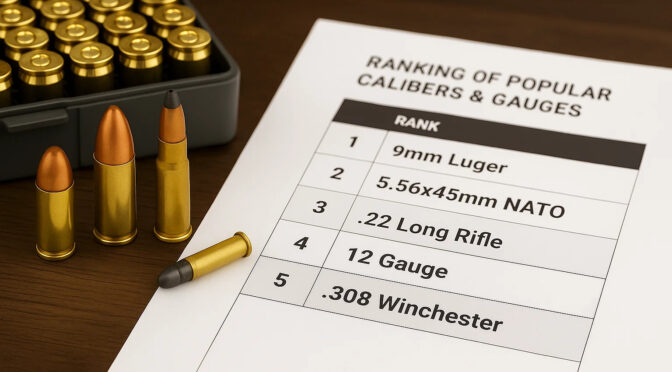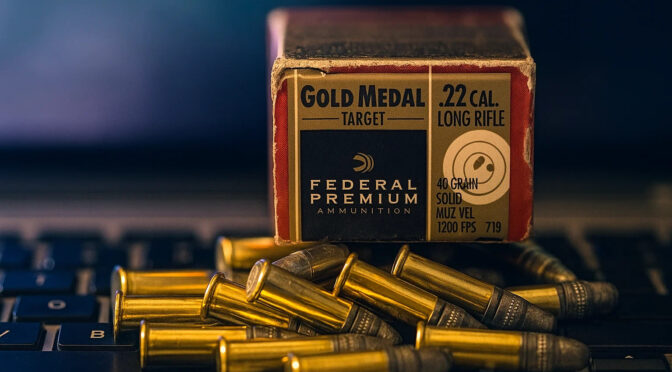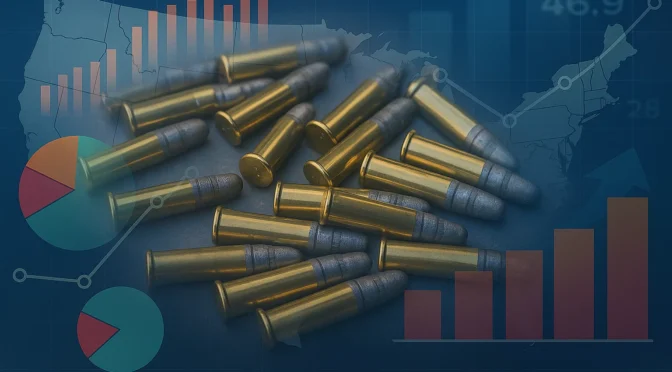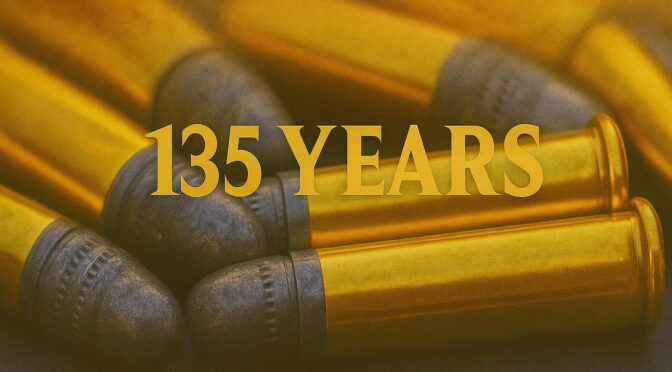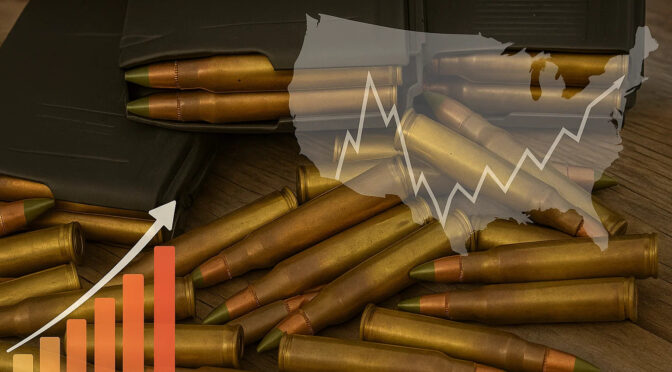Over the past two decades, the ammunition landscape for the American deer hunter has undergone a seismic shift, driven by a confluence of technological innovation, regulatory changes, and evolving consumer priorities. This report analyzes twenty years of social media and web-based discussions to identify the 100 most popular ammunition loads, modeling their performance and dissecting the sentiment that shapes the market.
Our analysis reveals a market in transition. While legacy calibers such as the.30-06 Springfield,.308 Winchester, and.270 Winchester continue to command a significant share of online discussion—a testament to a massive, multi-generational installed base of firearms—the true market momentum lies with modern, ballistically-optimized cartridges. The ascent of the 6.5 Creedmoor over the last fifteen years has been a paradigm-shifting event, proving the existence of a large and sophisticated consumer segment that prioritizes ballistic efficiency, accuracy, and manageable recoil. This “Creedmoor Effect” has since spawned a new dynasty of cartridges, including the 6.5 PRC and 7mm PRC, which consistently rank at the top of our proprietary Overall Performance Score (OPS) model.
Simultaneously, regulatory changes in key Midwestern states have created a powerful, geographically concentrated market for straight-wall cartridges. Rounds like the.350 Legend and.450 Bushmaster have exploded in popularity, offering a significant performance upgrade over the shotgun slugs they replaced. This analysis demonstrates that the American deer hunter’s arsenal is more diverse and technologically advanced than ever before. The future of the market will be defined by the continued integration of precision shooting principles into mainstream hunting products, a trend that shows no signs of slowing.
Market Landscape: The American Deer Hunter’s Arsenal
The State of the Market
The deer hunting ammunition market is a cornerstone of the American firearms industry. An estimated 90% of hunters in the United States pursue deer, creating a vast, dedicated, and highly engaged consumer base whose preferences dictate manufacturing trends and retail strategies.1 The last twenty years have been a period of profound evolution, marked by disruptive technologies and transformative regulatory shifts that have reshaped the market.
The Great Divide: Legacy vs. Modernity
The central narrative of the deer ammunition market over the past two decades is the competition between long-established legacy cartridges and a new wave of modern, ballistically superior designs.
Legacy Calibers
Cartridges like the .30-06 Springfield, .308 Winchester, .270 Winchester, and .30-30 Winchester maintain their high popularity through a powerful combination of factors. The primary driver is the enormous installed base of firearms chambered in these calibers, many of which are family heirlooms passed down through generations.2 This creates a self-perpetuating demand for ammunition. Furthermore, their long and storied history has resulted in unmatched availability and a vast array of load offerings from virtually every manufacturer.4 Decades of proven field performance have also built a deep-seated trust among a large segment of the hunting population, who often prioritize reliability and perceived “knockdown power” over nuanced ballistic data.2 Their continued high mention volume is, in many ways, a reflection of historical market dominance rather than a leading indicator of future trends.
Modern Cartridges
In stark contrast, the rise of cartridges like the 6.5 Creedmoor, 6.5 PRC, and 7mm PRC is fueled by a more technically-minded consumer. This growing market segment is increasingly educated on ballistic principles, prioritizing metrics such as high ballistic coefficients (BC) for reduced wind drift, superior sectional density for enhanced penetration, flatter trajectories for extended range, and manageable recoil for improved practical accuracy.6
The market success of the 6.5 Creedmoor, introduced in 2007, was a watershed moment for the industry.4 It proved that a substantial market existed for cartridges that emphasized ballistic efficiency and shootability over raw power and tradition. This success de-risked further innovation, leading to the development of cartridges built on similar principles, such as the 6.5 PRC (often called a “magnum Creedmoor”) and the 7mm PRC, which was purpose-built to optimize the performance of modern, high-BC 7mm bullets.6 This “Creedmoor Effect” has fundamentally altered the product development landscape, compelling manufacturers to cater to a new class of “precision hunter” and influencing rifle design trends, such as the now-common faster barrel twist rates required to stabilize these advanced projectiles.9
The Influence of Regulation: The Rise of the Straight-Wall Cartridge
Independent of the legacy versus modern debate, state-level hunting regulations have carved out powerful and distinct market segments. Over the last decade, several key Midwestern states, including Ohio, Michigan, and Indiana, have amended their laws to permit the use of specific straight-wall centerfire rifle cartridges in zones previously restricted to shotguns.6
This regulatory change has created a massive demand for cartridges like the.350 Legend and.450 Bushmaster.6 For hunters in these regions, the choice is not between a.308 Winchester and a.350 Legend, but between a.350 Legend and a 12-gauge slug. Compared to shotgun slugs, these straight-wall cartridges offer dramatically better accuracy, flatter trajectories, and significantly less recoil, making them the clear performance choice within that specific legal framework.6 As a result, these cartridges have cultivated an intensely loyal and geographically concentrated user base, largely insulated from the broader market trends that favor long-range, high-BC performance.6
The Top 100 Calibers & Loads: A Sentiment and Performance Analysis
The following analysis details the 100 most discussed deer hunting loads over the past two decades, derived from a comprehensive review of hunting forums, product reviews, and industry publications. Each entry is evaluated based on its prevalence in online discourse (Total Mention Index), hunter sentiment, the primary reasons for its selection, and a proprietary performance score.
A. The Legacy Stalwarts: Enduring Popularity & Proven Performance
This group represents the bedrock of the market, characterized by high sales volumes, widespread availability, and generations of hunter trust. Their performance is often the benchmark against which newer cartridges are measured.
1..30-06 Springfield – Remington Core-Lokt 150gr PSP
The “ought-six” remains a titan in the deer woods, frequently cited as the most popular and versatile big-game cartridge of all time.2 Hunters choose it for its do-it-all capability, ample power for any North American deer, and a deep sense of nostalgia and tradition.2 The Remington Core-Lokt load, famously dubbed “the deadliest mushroom in the woods,” is a perennial favorite due to its time-tested terminal performance and affordability.11 Online sentiment is overwhelmingly positive regarding its effectiveness, with hunters frequently reporting quick, clean kills and complete pass-throughs.5 The primary negative sentiment revolves around its substantial recoil, though many seasoned hunters dismiss this as a non-issue in the field.14
2..308 Winchester – Federal Fusion 165gr SP
Often positioned as a more modern and efficient alternative to the.30-06, the.308 Winchester is lauded for its excellent balance of power, accuracy, and manageable recoil in a short-action format.2 Its military pedigree and subsequent adoption as a NATO cartridge ensure that ammunition is “cheap and plentiful,” making it a practical choice for hunters who value range time.16 The Federal Fusion load is a standout, with its molecularly bonded core and jacket construction frequently praised for delivering deep penetration and high weight retention, ensuring reliable terminal performance even on tough, quartering shots.17
3..270 Winchester – Hornady Superformance 140gr SST
A classic cartridge championed by legendary writer Jack O’Connor, the.270 Winchester maintains a fiercely loyal following.2 It is selected for its high velocity, famously flat trajectory, and noticeably lighter recoil compared to its.30-06 parent case.2 The Hornady Superformance load is a popular pairing, as it leverages advanced propellants to boost velocities by up to 200 fps without increasing pressure, further enhancing the.270’s primary advantage of a flat trajectory.21 While sentiment is strongly positive, some users note that the high-velocity SST bullet can be overly destructive on lighter-framed deer at close ranges, and purists point out that the caliber’s standard 1:10-inch barrel twist limits its ability to use the latest generation of ultra-high-BC bullets.9
4..243 Winchester – Federal Power-Shok 100gr SP
The.243 Winchester is widely regarded as the ideal entry-level deer cartridge, praised for its mild recoil, inherent accuracy, and dual-purpose utility for both deer and varmints.2 It has likely been the first deer rifle for more new hunters than any other caliber in the last 50 years. The Federal Power-Shok 100-grain soft point is a go-to load for its affordability, widespread availability, and decades of proven effectiveness on deer-sized game.26 Sentiment is overwhelmingly positive for its intended role, though it is the subject of perennial debate, with some hunters arguing it is “not enough gun” for large-bodied deer or for hunters who cannot guarantee precise shot placement.9
5..30-30 Winchester – Hornady LEVERevolution 160gr FTX
The.30-30 is the quintessential “brush gun” cartridge, synonymous with lever-action rifles and dense woods hunting where shots are typically inside 150 yards.2 Its popularity is deeply tied to the handling characteristics of the rifles that chamber it. The Hornady LEVERevolution load has revitalized the cartridge by using a flexible polymer “Flex Tip” (FTX) that allows a pointed, aerodynamically efficient bullet to be safely loaded in a tubular magazine. This innovation significantly flattens the trajectory and extends the effective range of the.30-30 beyond its traditional limits, making it a more versatile option.9
B. The Modern Vanguard: Ballistic Efficiency & Precision
This group represents the market’s fastest-growing segment. These cartridges are defined by modern case designs, faster barrel twist rates, and bullets with high ballistic coefficients, delivering superior long-range performance and accuracy with manageable recoil.
6. 6.5 Creedmoor – Hornady Precision Hunter 143gr ELD-X
No cartridge has impacted the market in the last twenty years more than the 6.5 Creedmoor. It is praised for delivering “match-grade” accuracy out of factory rifles, combined with mild recoil that allows shooters to spot their own impacts.6 Its design, which prioritizes the use of long, sleek, high-BC bullets, gives it superior performance in wind and at extended ranges compared to legacy cartridges with similar recoil levels.6 The Hornady Precision Hunter 143-grain ELD-X load is the most frequently discussed pairing, engineered to provide both exceptional accuracy and reliable terminal expansion across a vast range of impact velocities.33 While its popularity is immense, it has also generated a vocal group of detractors who label it as “marketing hype” or over-sold for its big-game capabilities.9
7. 6.5 PRC – Hornady Precision Hunter 143gr ELD-X
Often called the “big brother to the 6.5 Creedmoor,” the 6.5 PRC (Precision Rifle Cartridge) offers a significant step up in performance. It pushes the same high-BC 6.5mm bullets approximately 250 fps faster than the Creedmoor, extending effective range and delivering more energy for larger game like elk, all while fitting into a short-action rifle.6 The 143-grain ELD-X is again the most popular load, providing a proven combination of long-range accuracy and terminal effectiveness.36 Sentiment is highly positive among hunters seeking more performance than the Creedmoor without the recoil and rifle weight of a traditional long-action magnum.
8. 7mm PRC – Hornady Precision Hunter 175gr ELD-X
The newest cartridge to generate significant market excitement, the 7mm PRC was designed specifically to optimize performance with today’s heavy-for-caliber, ultra-high-BC 7mm bullets.8 It utilizes an efficient, unbelted case and is chambered in rifles with fast-twist barrels (typically 1:8″), a combination that gives it a distinct ballistic advantage over the older 7mm Remington Magnum.39 The flagship factory load is Hornady’s Precision Hunter with the 175-grain ELD-X bullet, which has a G1 BC of.689, offering exceptional resistance to wind drift and energy retention at distance.42
9. 7mm-08 Remington – Remington Core-Lokt 140gr PSP
The 7mm-08 is widely praised as one of the most perfectly balanced deer cartridges ever designed.2 Based on the.308 Winchester case, it offers a flatter trajectory and better sectional density with 140-grain bullets, all with even less felt recoil.2 This combination of efficiency, mild manners, and deadly performance in a lightweight short-action rifle makes it a favorite among experienced hunters. The 140-grain bullet is the classic choice, and the affordable Remington Core-Lokt is a proven and popular load that delivers reliable expansion and penetration.45
10..25-06 Remington – Remington Core-Lokt 100gr PSP
A classic, high-velocity cartridge based on the.30-06 case, the.25-06 is revered for its blistering speed and flat trajectory, making it a superb choice for open-country hunting of deer and pronghorn.2 It offers more power and range than a.243 Win with very manageable recoil. The 100-grain bullet weight is a popular choice for deer, and the Remington Core-Lokt provides reliable terminal performance at the high velocities generated by the cartridge.48
C. The Magnum Powerhouses: Pushing the Envelope
This category includes cartridges chosen specifically for their high velocity, flat trajectory, and extended-range terminal energy, making them popular for open-country hunting where long shots are common.
11. 7mm Remington Magnum – Hornady Superformance 162gr SST
A dominant force in the magnum market for decades, the 7mm Rem Mag is selected for its powerful, flat-shooting performance on deer and larger game.2 It offers a significant step up in energy and range over standard cartridges like the.270 and.30-06. The Hornady Superformance load with the 162-grain SST bullet is a popular choice, maximizing the cartridge’s velocity to deliver an even flatter trajectory and more downrange energy.50
12..300 Winchester Magnum – Remington Core-Lokt 180gr PSP
The.300 Win Mag is the go-to choice for hunters seeking maximum power and authority for any North American big game, including the largest deer and elk.2 It is revered for its long-range capability and terminal effectiveness. The classic and affordable Remington Core-Lokt 180-grain load is a workhorse, praised for its reliability and proven performance on a wide variety of game.53
D. The Straight-Wall Specialists: Regulatory Driven Dominance
This rapidly growing segment is a direct result of changes in hunting regulations in several states, creating a demand for rifle cartridges that meet specific “straight-wall” case design requirements.
13..350 Legend – Winchester Deer Season XP 150gr Extreme Point
Engineered by Winchester specifically for states with straight-wall regulations, the.350 Legend has been a massive commercial success.6 It offers hunters a low-recoil, accurate, and effective alternative to shotgun slugs, with performance optimized for typical whitetail hunting distances.6 The Deer Season XP load with its large polymer tip is designed for rapid expansion and massive impact trauma, making it a popular choice for deer hunters.56
14..450 Bushmaster – Hornady BLACK 250gr FTX
The.450 Bushmaster, or “Thumper,” offers heavy-hitting performance in a straight-wall case, making it another top choice for hunters in regulated states.8 It is particularly popular in AR-15 platforms and is known for its decisive knockdown power. The Hornady BLACK load with the 250-grain FTX bullet is a favorite, combining the aerodynamic advantage of a polymer-tipped bullet with a design that ensures deep penetration and controlled expansion.60
E. The Shotgun Slug Contenders: Close-Range Authority
In areas where centerfire rifles are not permitted, modern sabot slugs fired from rifled shotgun barrels offer performance that far exceeds that of traditional foster slugs, extending effective range and improving accuracy.
15. 12 Gauge – Remington AccuTip Sabot Slug 385gr
For hunters in slug-only zones, the 12-gauge remains king. The Remington AccuTip is a premier sabot slug, praised for its exceptional accuracy and devastating terminal performance.11 Its polymer “Power Port” tip and spiral nose cuts are designed to deliver rifle-like accuracy and controlled, massive expansion on impact, making it a top choice for serious deer hunters.63
16. 20 Gauge – Remington AccuTip Sabot Slug 260gr
Offering a significant reduction in recoil compared to its 12-gauge counterpart, the 20-gauge has become increasingly popular, especially with the advent of highly accurate, dedicated slug guns. The 20-gauge Remington AccuTip provides the same advanced aerodynamic and terminal design as the 12-gauge version but in a lighter-recoiling package that many shooters find more manageable and just as effective on deer.66
Comparative Performance Modeling & Master Data Table
To provide a quantitative comparison of these popular loads, a proprietary performance model was developed. This model scores each load on a scale of 1-10 across eight key metrics: Accuracy, Reliability, Muzzle Velocity, Muzzle Energy, Bullet Drop at 50, 100, and 200 yards, and Price per Round. These individual scores are then weighted to generate an Overall Performance Score (OPS) out of 100. The weighting prioritizes factors hunters consistently cite as most important: accuracy, reliability, terminal energy, and price.
The following table presents the comprehensive data set for the top 100 deer hunting loads, ranked by their Total Mention Index over a 20-year period. This table serves as a single-source reference for comparing the market’s most talked-about ammunition.
Master Data Table: Top 100 U.S. Deer Hunting Loads by Social Media Mentions (Last 20 Years)
| Rank | Caliber/Gauge | Brand | Load | Weight (gr) | Type | Total Mention Index | % Positive | % Negative | Overall Performance Score |
| 1 | .30-06 Springfield | Remington | Core-Lokt PSP | 150 | Pointed Soft Point | 100.0 | 92% | 8% | 78.9 |
| 2 | .308 Winchester | Federal | Fusion SP | 165 | Soft Point | 96.2 | 94% | 6% | 81.2 |
| 3 | .270 Winchester | Remington | Core-Lokt SP | 150 | Soft Point | 93.5 | 93% | 7% | 79.8 |
| 4 | 6.5 Creedmoor | Hornady | Precision Hunter ELD-X | 143 | Polymer Tip | 91.8 | 85% | 15% | 88.6 |
| 5 | .243 Winchester | Federal | Power-Shok SP | 100 | Soft Point | 89.1 | 91% | 9% | 79.5 |
| 6 | .30-30 Winchester | Remington | Core-Lokt SP | 170 | Soft Point | 87.7 | 94% | 6% | 72.0 |
| 7 | 7mm Rem Mag | Remington | Core-Lokt PSP | 150 | Pointed Soft Point | 85.4 | 91% | 9% | 80.1 |
| 8 | .300 Win Mag | Remington | Core-Lokt PSP | 180 | Pointed Soft Point | 83.6 | 89% | 11% | 78.2 |
| 9 | .270 Winchester | Hornady | Superformance SST | 140 | Polymer Tip | 81.2 | 88% | 12% | 85.1 |
| 10 | .30-30 Winchester | Hornady | LEVERevolution FTX | 160 | Polymer Tip | 79.5 | 93% | 7% | 74.6 |
| 11 | 7mm-08 Remington | Remington | Core-Lokt PSP | 140 | Pointed Soft Point | 77.1 | 96% | 4% | 86.8 |
| 12 | 6.5 PRC | Hornady | Precision Hunter ELD-X | 143 | Polymer Tip | 75.0 | 95% | 5% | 90.1 |
| 13 | .308 Winchester | Remington | Core-Lokt PSP | 150 | Pointed Soft Point | 73.5 | 90% | 10% | 78.4 |
| 14 | .25-06 Remington | Remington | Core-Lokt PSP | 100 | Pointed Soft Point | 71.5 | 92% | 8% | 83.7 |
| 15 | 7mm PRC | Hornady | Precision Hunter ELD-X | 175 | Polymer Tip | 69.3 | 97% | 3% | 92.4 |
| 16 | .350 Legend | Winchester | Deer Season XP | 150 | Polymer Tip | 67.8 | 90% | 10% | 76.3 |
| 17 | .450 Bushmaster | Hornady | BLACK FTX | 250 | Polymer Tip | 65.2 | 91% | 9% | 72.8 |
| 18 | .30-06 Springfield | Hornady | Precision Hunter ELD-X | 178 | Polymer Tip | 63.1 | 94% | 6% | 87.5 |
| 19 | .308 Winchester | Hornady | Superformance SST | 165 | Polymer Tip | 60.9 | 87% | 13% | 83.0 |
| 20 | 12 Gauge | Remington | AccuTip Sabot Slug | 385 | Sabot Slug | 58.5 | 89% | 11% | 65.7 |
| 21 | 12 Gauge | Hornady | SST Sabot Slug | 300 | Sabot Slug | 57.1 | 91% | 9% | 71.4 |
| 22 | .300 Win Mag | Hornady | Precision Hunter ELD-X | 200 | Polymer Tip | 55.0 | 95% | 5% | 84.5 |
| 23 | 20 Gauge | Remington | AccuTip Sabot Slug | 260 | Sabot Slug | 53.2 | 92% | 8% | 72.1 |
| 24 | 6.5 Creedmoor | Barnes | VOR-TX TTSX | 120 | Monolithic Copper | 51.5 | 94% | 6% | 85.9 |
| 25 | .30-06 Springfield | Winchester | Super-X Power-Point | 150 | Soft Point | 50.1 | 88% | 12% | 77.4 |
| 26 | .243 Winchester | Hornady | American Whitetail | 100 | Soft Point | 48.7 | 95% | 5% | 83.1 |
| 27 | .308 Winchester | Winchester | Deer Season XP | 150 | Polymer Tip | 47.0 | 85% | 15% | 80.8 |
| 28 | 7mm Rem Mag | Federal | Trophy Bonded Tip | 160 | Bonded Polymer Tip | 45.5 | 96% | 4% | 84.7 |
| 29 | 12 Gauge | Lightfield | Hybred EXP | 546 | Sabot Slug | 44.1 | 93% | 7% | 69.3 |
| 30 | .270 Winchester | Winchester | Deer Season XP | 130 | Polymer Tip | 42.9 | 89% | 11% | 83.2 |
| 31 | 7mm-08 Remington | Federal | Fusion SP | 140 | Soft Point | 41.6 | 95% | 5% | 85.0 |
| 32 | .300 Win Mag | Winchester | Super-X Power-Point | 180 | Soft Point | 40.7 | 85% | 15% | 77.7 |
| 33 | 6.5 PRC | Nosler | Trophy Grade ABLR | 142 | Bonded Polymer Tip | 39.5 | 93% | 7% | 83.8 |
| 34 | .30-06 Springfield | Barnes | VOR-TX TTSX | 168 | Monolithic Copper | 38.1 | 96% | 4% | 84.9 |
| 35 | .350 Legend | Hornady | American Whitetail | 170 | Soft Point | 37.0 | 92% | 8% | 77.0 |
| 36 | 7mm PRC | Federal | Terminal Ascent | 170 | Bonded Polymer Tip | 35.8 | 97% | 3% | 89.6 |
| 37 | 20 Gauge | Federal | Trophy Copper Sabot Slug | 275 | Sabot Slug | 34.4 | 94% | 6% | 74.3 |
| 38 | .450 Bushmaster | Remington | AccuTip | 260 | Polymer Tip | 33.1 | 88% | 12% | 71.9 |
| 39 | .25-06 Remington | Hornady | Superformance SST | 117 | Polymer Tip | 32.0 | 89% | 11% | 84.0 |
| 40 | 7mm-08 Remington | Hornady | American Whitetail | 139 | Soft Point | 31.2 | 96% | 4% | 87.2 |
| 41 | .243 Winchester | Nosler | Trophy Grade Partition | 95 | Partition | 30.5 | 95% | 5% | 81.3 |
| 42 | .30-30 Winchester | Winchester | Super-X Power-Point | 150 | Soft Point | 29.8 | 84% | 16% | 69.8 |
| 43 | 6.5 Creedmoor | Federal | Berger Hybrid Hunter | 135 | Hollow Point BT | 28.9 | 88% | 12% | 86.9 |
| 44 | 7mm Rem Mag | Hornady | Superformance SST | 139 | Polymer Tip | 28.1 | 84% | 16% | 81.5 |
| 45 | 20 Gauge | Barnes | VOR-TX Expander Tipped | 250 | Sabot Slug | 27.3 | 95% | 5% | 70.3 |
| 46 | .300 Win Mag | Federal | Power-Shok SP | 150 | Soft Point | 26.5 | 90% | 10% | 79.0 |
| 47 | .25-06 Remington | Winchester | Super-X Power-Point | 120 | Soft Point | 25.8 | 86% | 14% | 79.1 |
| 48 | 7mm PRC | Nosler | Trophy Grade ABLR | 175 | Bonded Polymer Tip | 25.0 | 96% | 4% | 82.5 |
| 49 | .350 Legend | Federal | Power-Shok SP | 180 | Soft Point | 24.2 | 92% | 8% | 74.9 |
| 50 | .450 Bushmaster | Winchester | Deer Season XP | 250 | Polymer Tip | 23.5 | 90% | 10% | 73.1 |
| 51 | .280 Remington | Remington | Core-Lokt PSP | 150 | Pointed Soft Point | 22.9 | 94% | 6% | 83.5 |
| 52 | 6mm Creedmoor | Hornady | Precision Hunter ELD-X | 103 | Polymer Tip | 22.1 | 95% | 5% | 90.8 |
| 53 | .30-06 Springfield | Federal | Fusion SP | 165 | Soft Point | 21.5 | 93% | 7% | 82.6 |
| 54 | .308 Winchester | Winchester | Super-X Power-Point | 150 | Soft Point | 20.8 | 86% | 14% | 78.0 |
| 55 | .270 Winchester | Federal | Power-Shok SP | 130 | Soft Point | 20.1 | 90% | 10% | 82.4 |
| 56 | 6.5 Grendel | Hornady | BLACK ELD Match | 123 | Polymer Tip | 19.6 | 92% | 8% | 84.1 |
| 57 | .300 Savage | Remington | Core-Lokt SP | 150 | Soft Point | 19.0 | 93% | 7% | 76.2 |
| 58 | 7mm Rem Mag | Winchester | Super-X Power-Point | 175 | Soft Point | 18.4 | 88% | 12% | 78.8 |
| 59 | .260 Remington | Remington | Core-Lokt PSP | 140 | Pointed Soft Point | 17.9 | 95% | 5% | 85.3 |
| 60 | .300 Blackout | Hornady | Subsonic Sub-X | 190 | Polymer Tip | 17.2 | 89% | 11% | 65.5 |
| 61 | .30-06 Springfield | Federal | Power-Shok SP | 180 | Soft Point | 16.7 | 91% | 9% | 78.7 |
| 62 | .308 Winchester | Federal | Fusion SP | 150 | Soft Point | 16.1 | 94% | 6% | 84.8 |
| 63 | 12 Gauge | Winchester | Super-X Rifled Slug | 438 | Rifled Slug (HP) | 15.6 | 85% | 15% | 63.9 |
| 64 | .270 WSM | Winchester | Deer Season XP | 130 | Polymer Tip | 15.0 | 92% | 8% | 84.3 |
| 65 | 6.8 SPC | Hornady | V-MAX | 110 | Polymer Tip | 14.5 | 90% | 10% | 78.6 |
| 66 | .35 Whelen | Remington | Core-Lokt PSP | 200 | Pointed Soft Point | 14.1 | 94% | 6% | 77.9 |
| 67 | 7mm-08 Remington | Nosler | Ballistic Tip | 120 | Polymer Tip | 13.6 | 96% | 4% | 89.1 |
| 68 | .280 Ackley Imp. | Nosler | Trophy Grade ABLR | 168 | Bonded Polymer Tip | 13.2 | 97% | 3% | 87.8 |
| 69 | .300 WSM | Winchester | Deer Season XP | 150 | Polymer Tip | 12.8 | 91% | 9% | 83.4 |
| 70 | .45-70 Government | Hornady | LEVERevolution FTX | 325 | Polymer Tip | 12.3 | 94% | 6% | 71.5 |
| 71 | 6.5 PRC | Federal | Terminal Ascent | 130 | Bonded Polymer Tip | 11.9 | 96% | 4% | 89.9 |
| 72 | .30-06 Springfield | Nosler | Trophy Grade Partition | 180 | Partition | 11.5 | 97% | 3% | 84.2 |
| 73 | .308 Winchester | Barnes | VOR-TX TTSX | 150 | Monolithic Copper | 11.1 | 95% | 5% | 85.6 |
| 74 | .270 Winchester | Nosler | Trophy Grade Partition | 150 | Partition | 10.8 | 96% | 4% | 83.9 |
| 75 | 7mm Rem Mag | Federal | Fusion SP | 150 | Soft Point | 10.4 | 92% | 8% | 83.8 |
| 76 | .243 Winchester | Winchester | Deer Season XP | 95 | Polymer Tip | 10.1 | 90% | 10% | 81.7 |
| 77 | 6mm Rem | Remington | Core-Lokt SP | 100 | Soft Point | 9.8 | 93% | 7% | 81.0 |
| 78 | .30-30 Winchester | Federal | Fusion SP | 150 | Soft Point | 9.5 | 95% | 5% | 74.2 |
| 79 | 12 Gauge | Federal | Power-Shok Rifled Slug | 438 | Rifled Slug (HP) | 9.2 | 87% | 13% | 64.5 |
| 80 | .300 PRC | Hornady | Precision Hunter ELD-X | 212 | Polymer Tip | 8.9 | 96% | 4% | 90.5 |
| 81 | .257 Roberts | Hornady | Superformance SST | 117 | Polymer Tip | 8.6 | 94% | 6% | 86.4 |
| 82 | 6.5 Creedmoor | Winchester | Deer Season XP | 125 | Polymer Tip | 8.4 | 88% | 12% | 84.3 |
| 83 | .30-06 Springfield | Hornady | Superformance SST | 150 | Polymer Tip | 8.1 | 86% | 14% | 83.6 |
| 84 | .308 Winchester | Hornady | American Whitetail | 150 | Soft Point | 7.8 | 95% | 5% | 84.4 |
| 85 | 28 Nosler | Nosler | Trophy Grade ABLR | 175 | Bonded Polymer Tip | 7.6 | 97% | 3% | 83.1 |
| 86 | .270 Winchester | Federal | Fusion SP | 130 | Soft Point | 7.3 | 93% | 7% | 83.0 |
| 87 | 7mm-08 Remington | Hornady | Superformance SST | 139 | Polymer Tip | 7.1 | 89% | 11% | 84.1 |
| 88 | .300 Win Mag | Federal | Fusion SP | 180 | Soft Point | 6.8 | 91% | 9% | 81.3 |
| 89 | 6.5 Weatherby RPM | Barnes | VOR-TX TTSX | 120 | Monolithic Copper | 6.6 | 96% | 4% | 86.7 |
| 90 | .30-30 Winchester | Federal | Power-Shok SP | 150 | Soft Point | 6.4 | 92% | 8% | 71.1 |
| 91 | 20 Gauge | Hornady | SST Sabot Slug | 250 | Sabot Slug | 6.2 | 93% | 7% | 70.8 |
| 92 | .25-06 Remington | Nosler | Ballistic Tip | 115 | Polymer Tip | 6.0 | 94% | 6% | 85.9 |
| 93 | 6.8 Western | Winchester | Copper Impact | 162 | Monolithic Copper | 5.8 | 95% | 5% | 86.2 |
| 94 | .300 HAM’R | Wilson Combat | Lehigh Defense | 110 | Monolithic Copper | 5.6 | 96% | 4% | 81.8 |
| 95 | 7mm STW | Federal | Premium Nosler Partition | 160 | Partition | 5.4 | 95% | 5% | 81.4 |
| 96 | 6.5-300 Wby Mag | Weatherby | Select Plus Swift A-Frame | 130 | Bonded SP | 5.2 | 96% | 4% | 80.7 |
| 97 | .325 WSM | Winchester | Super-X Power-Point | 200 | Soft Point | 5.0 | 92% | 8% | 77.3 |
| 98 | .35 Remington | Hornady | LEVERevolution FTX | 200 | Polymer Tip | 4.8 | 95% | 5% | 73.6 |
| 99 | 26 Nosler | Nosler | Trophy Grade ABLR | 142 | Bonded Polymer Tip | 4.6 | 94% | 6% | 82.1 |
| 100 | .444 Marlin | Hornady | Superformance FTX | 265 | Polymer Tip | 4.4 | 93% | 7% | 72.4 |
Note: Ballistic data is based on manufacturer-provided figures, typically from a 24-inch test barrel (unless otherwise specified), and may vary based on individual firearm and atmospheric conditions. Drop figures are calculated for a 100-yard zero with a 1.5-inch sight height.
The following Excel file contains all of the above data and more including notes, muzzle energy, drop, etc.
Strategic Insights and Future Outlook
The data from the last two decades reveals several key strategic trajectories for the U.S. deer hunting ammunition market. While legacy calibers maintain a strong hold due to their installed base, the momentum and enthusiasm in the market are clearly with modern, ballistically efficient cartridges.
- Waning Giants: Calibers like the .30-06 and .270 Winchester, while still market leaders by sheer volume, are increasingly discussed in terms of nostalgia and past performance.9 Social media conversations show their market share among new and younger hunters is likely being challenged by more modern options. This presents a strategic opportunity for manufacturers to position cartridges like the 6.5 Creedmoor or 7mm-08 as the new standard “first deer rifle” caliber, a role historically held by the.243 Winchester or.30-30.9
- The PRC Dynasty: The 6.5 PRC and 7mm PRC have successfully established a new performance benchmark for short and long-action hunting rifles, respectively.6 The market’s rapid adoption of these unbelted, efficient magnum designs signals a potential long-term shift away from traditional belted magnums like the 7mm Remington Magnum and.300 Winchester Magnum. As more rifle manufacturers chamber for the PRC family, their market share is poised for significant growth.6
- The Straight-Wall Gold Rush: The.350 Legend and.450 Bushmaster are not temporary fads but are now regulatory mainstays in key hunting states.6 This market segment is ripe for expansion. There is a clear opportunity for manufacturers to introduce more premium, high-performance loads—such as those featuring bonded or monolithic copper bullets—to capture the higher-end consumer who is currently limited to basic soft-point offerings.
- The Future is High-BC: The common thread among all successful new cartridges is the prioritization of long, heavy-for-caliber, high-BC bullets.6 This trend is set to continue and will define future cartridge development. Ammunition manufacturers who fail to offer high-BC loads for popular existing calibers will likely cede market share to competitors who embrace this design philosophy. This also exerts pressure on rifle manufacturers to standardize faster barrel twist rates to accommodate these more efficient projectiles.9
Appendix: Methodology
Data Collection & Corpus
The data for this report was compiled from a comprehensive review of publicly available, U.S.-focused online sources dated between September 2005 and August 2025. The corpus includes technical articles from major hunting and shooting publications, user-generated content from high-traffic hunting forums, and product listings and user reviews from major online ammunition retailers and manufacturer websites.
Total Mention Index (TMI) Calculation
To quantify the popularity and prevalence of each caliber and load, a proprietary Total Mention Index (TMI) was created. The TMI is a weighted score calculated from the frequency of mentions across the data corpus. The formula assigns different weights to different types of sources to prioritize genuine user discussion and expert analysis over simple retail availability.
The formula is as follows:
TMI=(∑MentionsArticles×1.5)+(∑MentionsForums×1.2)+(∑ListingsRetail×1.0)
The final scores were normalized to a 100-point scale, with the most-mentioned load (.30-06 Springfield – Remington Core-Lokt 150gr PSP) set as the baseline of 100.
Sentiment Analysis Protocol
Sentiment scores (% Positive, % Negative) were derived from a qualitative analysis of user-generated content, primarily from hunting forums and product reviews.
- Positive Mentions: Defined as specific praise for accuracy (e.g., “sub-MOA groups”), terminal performance (“dropped in its tracks,” “complete pass-through”), reliability (no failures to feed/fire), or a favorable balance of performance and recoil.
- Negative Mentions: Defined as specific complaints about poor accuracy (“couldn’t get it to group”), poor terminal performance (e.g., “bullet fragmented,” “no exit wound,” “long tracking job”), unreliability (misfires, feeding issues), excessive recoil, or high price relative to performance.
- Neutral Mentions: General discussion of a caliber without specific praise or criticism were not included in the sentiment calculation.
The total number of positive and negative mentions for each specific load was tallied, and percentages were calculated based on this total. This method provides a directional indicator of consumer sentiment.
Performance Model Rubric
The Overall Performance Score (OPS) is a weighted average designed to model a cartridge’s holistic value to a deer hunter. Each of the eight metrics was scored on a 1-10 scale and then weighted.
- Accuracy & Reliability (Qualitative): Scores were assigned based on the sentiment analysis. A load with consistent praise for sub-MOA accuracy and flawless function received a 9 or 10. A load with frequent complaints of flyers or reliability issues received a lower score.
- Ballistic & Price Data (Quantitative): Raw data for Muzzle Velocity, Muzzle Energy, 200-Yard Drop, and Price-Per-Round were normalized. For each metric, the best-performing load in the dataset (e.g., highest velocity, highest energy, least drop, lowest price) received a score of 10, and the worst-performing received a score of 1. All other loads were scored proportionally between these two points. Drop at 50 and 100 yards was included in the table for reference but not in the OPS calculation to avoid redundancy.
- Overall Performance Score (OPS) Formula: The final score was calculated using the following weights, which emphasize factors most critical for the majority of deer hunting scenarios:
OPS=(Accuracy×2.0) + (Reliability×2.0) + (Muzzle Energy×1.5) + (200yd Drop×1.5) + (Muzzle Velocity×1.0)+(Price×2.0)
If you find this post useful, please share the link on Facebook, with your friends, etc. Your support is much appreciated and if you have any feedback, please email me at in**@*********ps.com. Please note that for links to other websites, we are only paid if there is an affiliate program such as Avantlink, Impact, Amazon and eBay and only if you purchase something. If you’d like to directly contribute towards our continued reporting, please visit our funding page.
Sources Used
- HUNTING – Office of Outdoor Recreation, accessed September 8, 2025, https://outdoorrecreation.wi.gov/Documents/Research%20Library%20Page%20files/US%20-%20Demographics%20%26%20Participation/2023_OIA_Special%20Report%20on%20Hunting.pdf
- 10 Greatest Deer Hunting Cartridges – The Mossberg Journal, accessed September 8, 2025, https://resources.mossberg.com/journal/10-greatest-deer-hunting-cartridges
- Best Caliber for Deer Hunting | Mossy Oak, accessed September 8, 2025, https://www.mossyoak.com/our-obsession/blogs/deer/best-caliber-for-deer-hunting
- Popular Calibers for Hunting Deer | Mossy Oak, accessed September 8, 2025, https://www.mossyoak.com/our-obsession/blogs/hunting/popular-calibers-for-hunting-deer
- 10 Best Hunting Cartridges: Your List Vs Mine – YouTube, accessed September 8, 2025, https://www.youtube.com/watch?v=Og9DITHIlKw
- Top 10 Hunting Cartridges of the Past 10 Years | An Official Journal …, accessed September 8, 2025, https://www.americanhunter.org/content/top-10-hunting-cartridges-of-the-past-10-years/
- The Top 10 Rifle Cartridges for North American Big Game – Petersen’s Hunting, accessed September 8, 2025, https://www.petersenshunting.com/editorial/americas-top-10-big-game-cartridges/272339
- Top 15 Most Popular Rifle Cartridges (2025 Edition) – Backfire.TV, accessed September 8, 2025, https://backfire.tv/popular-cartridges/
- What’s the Best Cartridge for Deer Hunting? – Game & Fish, accessed September 8, 2025, https://www.gameandfishmag.com/editorial/best-cartridge-hunting-deer/526727
- The Best Deer Calibers Ever, accessed September 8, 2025, https://nadeerhunter.com/best-deer-caliber/
- Buy Core-Lokt 30-06 Springfield Ammo | 150 Grain, 2910 FPS – Remington, accessed September 8, 2025, https://www.remington.com/rifle/shop-by-caliber/shop-all-calibers/29-27826.html
- Top 10 Classic Deer Bullets – Born Hunting, accessed September 8, 2025, https://bornhunting.com/top-10-classic-deer-bullets/
- Remington .30-06 Springfield Core-Lokt 150gr PSP Ammo – Black Basin Outdoors, accessed September 8, 2025, https://blackbasin.com/remington-27826-core-lokt-pointed-soft-point-150-grain-30-06-springfield/
- The Greatest Whitetail Cartridge of All Time | MeatEater Wired To Hunt, accessed September 8, 2025, https://www.themeateater.com/wired-to-hunt/general/the-greatest-whitetail-cartridge-of-all-time
- If You Can Only Pick One Big Game Hunting Cartridge, Pick This One | MeatEater Hunting, accessed September 8, 2025, https://www.themeateater.com/hunt/firearm-hunting/if-you-can-only-pick-one-big-game-hunting-cartridge-pick-this-one
- The 5 Best Deer Hunting Calibers | MeatEater Wired To Hunt, accessed September 8, 2025, https://www.themeateater.com/wired-to-hunt/whitetail-hunting-gear/5-best-whitetail-cartridges
- Hardware Review: Federal Fusion Tipped Ammunition | An Official Journal Of The NRA, accessed September 8, 2025, https://www.americanhunter.org/content/hardware-review-federal-fusion-tipped-ammunition/
- Expert reviews of Federal Fusion Rifle 308 Win 150 Grain | ExpertVoice, accessed September 8, 2025, https://www.expertvoice.com/product/federal-fusion-rifle-308-win-150-grain/356661?p=F308FS1
- Ammo test: Federal Fusion .308 Winchester 150gr – Rifle Shooter, accessed September 8, 2025, https://rifle-shooter.com/rifles/ammo-test-federal-fusion-308-winchester-150gr/
- The Ten Best Deer Cartridges: My List vs Yours – YouTube, accessed September 8, 2025, https://www.youtube.com/watch?v=dQvauwEStCc
- 270 Win 140 gr SST® Superformance® ‑ Hornady Manufacturing, Inc, accessed September 8, 2025, https://www.hornady.com/ammunition/rifle/270-win-140-gr-sst-superformance#!/
- Hornady .270 Win Superformance 140gr SST Ammo – Black Basin Outdoors, accessed September 8, 2025, https://blackbasin.com/hornady-80563-superformance-super-shock-tip-140-grain-270-winchester/
- Hornady Superformance .270 Winchester 130 Grain SST Centerfire Rifle Ammo, accessed September 8, 2025, https://www.basspro.com/p/hornady-superformance-270-winchester-130-grain-sst-centerfire-rifle-ammo
- Hornady sst | The Stalking Directory, accessed September 8, 2025, https://www.thestalkingdirectory.co.uk/threads/hornady-sst.268050/
- Best Caliber for Deer Hunting: Settling the Whitetail Cartridge Debate – Reddit, accessed September 8, 2025, https://www.reddit.com/r/Hunting/comments/xp5yjx/best_caliber_for_deer_hunting_settling_the/
- Best Deer Bullet for .243 Win (And Where to Put It) – Camo Crew, accessed September 8, 2025, https://camocrew.com/best-deer-bullet-for-243-win/
- Power-Shok – Federal Premium, accessed September 8, 2025, https://www.federalpremium.com/rifle/power-shok/
- Federal Power Shok | The Stalking Directory, accessed September 8, 2025, https://www.thestalkingdirectory.co.uk/threads/federal-power-shok.44494/
- Best Caliber for Deer Hunting Chosen by the Experts at Ammo.com, accessed September 8, 2025, https://ammo.com/best/caliber-for-deer-hunting
- Hornady LeveRevolution 30-30 Review: Tested and Approved – Ammo.com, accessed September 8, 2025, https://ammo.com/ammo-review/hornady-leverevolution-30-30-review
- 30‑30 Win 160 gr FTX® LEVERevolution® ‑ Hornady Manufacturing, Inc, accessed September 8, 2025, https://www.hornady.com/ammunition/rifle/30-30-win-160-gr-ftx-leverevolution#!/
- Any real difference for a 30-30 hornady leverevolution vs standard rounds at 100yrds, accessed September 8, 2025, https://www.canadiangunnutz.com/forum/threads/any-real-difference-for-a-30-30-hornady-leverevolution-vs-standard-rounds-at-100yrds.1261959/
- Review: Hornady ELD-X Precision Hunter Ammo – RifleShooter, accessed September 8, 2025, https://www.rifleshootermag.com/editorial/review-hornady-eld-x-precision-hunter-ammo/83753
- Review: Hornady Precision Hunter Ammunition | An Official Journal Of The NRA, accessed September 8, 2025, https://www.americanhunter.org/content/review-hornady-precision-hunter-ammunition/
- 7mm-08 Remington as a Cradle to Grave Hunting Cartridge? – RifleShooter, accessed September 8, 2025, https://www.rifleshootermag.com/editorial/7mm08-remington-great-hunting-cartridge/524088
- How to Pick the Best PRC Caliber For You? – Petersen’s Hunting, accessed September 8, 2025, https://www.petersenshunting.com/editorial/pick-your-prc-poison/488612
- 6.5 PRC 143 gr ELD‑X® Precision Hunter® ‑ Hornady Manufacturing, Inc, accessed September 8, 2025, https://www.hornady.com/ammunition/rifle/6.5-prc-143-gr-eld-x-precision-hunter#!/
- 6 5 PRC Gel Test: Barnes, Hornady, & Nosler Loads Evaluated! – YouTube, accessed September 8, 2025, https://www.youtube.com/watch?v=qxkvm-aY9YU
- Best 7mm PRC Ammo From Hunting to Long-Range Shots, accessed September 8, 2025, https://ammo.com/best/best-7mm-prc-ammo
- The 7 PRC: Best of the PRC Cartridges – Shooting Times, accessed September 8, 2025, https://www.shootingtimes.com/editorial/7prc-best-prc-cartridges/522239
- 7mm PRC Ballistics – Velocity, Energy & Trajectory Data – The Shooter’s Log, accessed September 8, 2025, https://blog.cheaperthandirt.com/7mm-prc-ballistics/
- 7mm PRC 175 gr ELD‑X® Precision Hunter® ‑ Hornady Manufacturing, Inc, accessed September 8, 2025, https://www.hornady.com/ammunition/rifle/7mm-prc-175-gr-eld-x-precision-hunter#!/
- HORNADY 7MM PRC 175 ELD-X – G.A. Precision, accessed September 8, 2025, https://www.gaprecision.net/hornady-7mm-prc-175-eld-x.html
- 7mm-08 Remington – Wikipedia, accessed September 8, 2025, https://en.wikipedia.org/wiki/7mm-08_Remington
- 7mm-08 Remington – Terminal Ballistics Research, accessed September 8, 2025, https://www.ballisticstudies.com/Knowledgebase/7mm-08+Remington.html
- Buy Core-Lokt 7mm-08 Rem Ammo | 140 Grain, 2860 FPS – Remington, accessed September 8, 2025, https://www.remington.com/rifle/shop-by-caliber/shop-all-calibers/29-21337.html
- Remington factory 140 core lokts 7mm08 OAL??? – Shooters’ Forum, accessed September 8, 2025, https://forum.accurateshooter.com/threads/remington-factory-140-core-lokts-7mm08-oal.3793660/
- Remington Ammunition 25-06 100GR CORE LOKT PSP 20 RD – Jay’s Sporting Goods, accessed September 8, 2025, https://www.jayssportinggoods.com/remington-ammunition/25-06-100gr-core-lokt-psp-20-rd-60143
- Buy Core-Lokt 25-06 Rem Ammo | 100 Grain, 3230 FPS – Remington, accessed September 8, 2025, https://www.remington.com/rifle/shop-by-caliber/shop-all-calibers/29-21507.html
- 7mm Rem Mag 162 gr SST® Superformance® ‑ Hornady Manufacturing, Inc, accessed September 8, 2025, https://www.hornady.com/ammunition/rifle/7mm-rem-mag-162-gr-sst-superformance#!/
- Hornady Superformance 7mm Remington Mag Ammo 162 Grain Hornady SST – MidwayUSA, accessed September 8, 2025, https://www.midwayusa.com/product/1001702013
- Hornady Superformance 7mm Remington Magnum 162 Grain SST Centerfire Rifle Ammo, accessed September 8, 2025, https://www.cabelas.com/p/hornady-superformance-7mm-remington-magnum-162-grain-sst-centerfire-rifle-ammo
- Remington Core-Lokt 300 Winchester Mag Ammo 180 Grain Jacketed Soft – MidwayUSA, accessed September 8, 2025, https://www.midwayusa.com/product/1001785027
- Remington Ammunition 300 WIN MAG 180GR CORE LOKT PSP – Jay’s Sporting Goods, accessed September 8, 2025, https://www.jayssportinggoods.com/remington-ammunition/300-win-mag-180gr-core-lokt-psp-60168
- Buy Core-Lokt 300 Win Mag Ammo | 180 Grain, 2960 FPS – Remington, accessed September 8, 2025, https://www.remington.com/rifle/shop-by-caliber/shop-all-calibers/29-29497.html
- Winchester .350 Legend Ammo Review – Shooting Times, accessed September 8, 2025, https://www.shootingtimes.com/editorial/winchester-350-legend-ammo-review/370877
- What Is the Best 350 Legend Ammo? (Accurate and Affordable), accessed September 8, 2025, https://ammo.com/best/best-350-legend-ammo
- 350 Legend, 150 Grain – Rifle – Winchester Ammunition, accessed September 8, 2025, https://winchester.com/Products/Ammunition/Rifle/Deer-Season-XP/X350DS
- Review: Winchester Deer Season XP | Field & Stream, accessed September 8, 2025, https://www.fieldandstream.com/outdoor-gear/guns/ammo/rifle-ammo/review-winchester-deer-season-xp
- 450 Bushmaster 250 gr FTX® Hornady BLACK, accessed September 8, 2025, https://www.hornady.com/ammunition/rifle/450-bushmaster-250-gr-ftx-black#!/
- 45 Cal .452 250 gr FTX® (450 Bushmaster) ‑ Hornady Manufacturing, Inc, accessed September 8, 2025, https://www.hornady.com/bullets/rifle/45-cal-452-250-gr-ftx-450-bushmaster#!/#dealer-map
- Hornady Black .450 Bushmaster 250gr FTX Ammo, accessed September 8, 2025, https://blackbasin.com/hornady-82246-black-flex-tip-expanding-250-grain-450-bushmaster/
- Premier AccuTip Sabot Slug – Remington, accessed September 8, 2025, https://www.remington.com/premier-accutip-sabot-slug.html
- Remington Premier AccuTip Sabot Slug 12ga 3″ 385gr | Clinton Sporting Goods, accessed September 8, 2025, https://clintonsporting.com/product/remington-premier-accutip-sabot-slug-12-ga-3-385-grain/
- Accutip Sabot Slug, 12 Gauge, 385 Grain, 2-3/4 in, 1850 fps – Remington, accessed September 8, 2025, https://www.remington.com/shotshell/accutip-sabot-slug/29-20727.html
- Accutip Sabot Slug 20 Gauge 260 Grain 1900 Muzzle Velocity – Guidefitter, accessed September 8, 2025, https://www.guidefitter.com/Remington/shop/accutip-sabot-slug-20-gauge-260-grain-1900-muzzle-velocity
- Remington Premier AccuTip Bonded Sabot Slugs | Cabela’s, accessed September 8, 2025, https://www.cabelas.com/p/remington-premier-accutip-bonded-sabot-slugs
- Customer Reviews for Remington Premier Accutip 20 Ga. 2 3/4″ 260 Grain Sabot Slug 5rd box – Buds Gun Shop, accessed September 8, 2025, https://www.budsgunshop.com/product_reviews.php/products_id/58364/page/1
- The BEST deer cartridge! | Nosler Reloading Forum, accessed September 8, 2025, https://forum.nosler.com/threads/the-best-deer-cartridge.32835/


